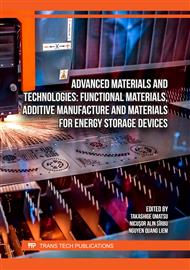[1]
D.S. Idris, A. Roy, Synthesis of Bimetallic Nanoparticles and Applications—An Updated Review, Crystals. 13 (2023) 637.
DOI: 10.3390/cryst13040637
Google Scholar
[2]
S. Gao, S. Hao, Z. Huang, Y. Yuan, S. Han, L. Lei, X. Zhang, R. Shahbazian-Yassar, J. Lu, Synthesis of high-entropy alloy nanoparticles on supports by the fast moving bed pyrolysis, Nat Commun. 11 (2020) 2016.
DOI: 10.1038/s41467-020-15934-1
Google Scholar
[3]
A.G. Díez, M. Rincón-Iglesias, S. Lanceros-Méndez, J. Reguera, E. Lizundia, Multicomponent magnetic nanoparticle engineering: the role of structure-property relationship in advanced applications, Materials Today Chemistry. 26 (2022) 101220.
DOI: 10.1016/j.mtchem.2022.101220
Google Scholar
[4]
G. Feng, F. Ning, J. Song, H. Shang, K. Zhang, Z. Ding, P. Gao, W. Chu, D. Xia, Sub-2 nm Ultrasmall High-Entropy Alloy Nanoparticles for Extremely Superior Electrocatalytic Hydrogen Evolution, J. Am. Chem. Soc. 143 (2021) 17117–17127.
DOI: 10.1021/jacs.1c07643
Google Scholar
[5]
A.S. Konopatsky, K.L. Firestein, N.D. Evdokimenko, A.L. Kustov, V.S. Baidyshev, I.V. Chepkasov, Z.I. Popov, A.T. Matveev, I.V. Shetinin, D.V. Leybo, I.N. Volkov, A.M. Kovalskii, D. Golberg, D.V. Shtansky, Microstructure and catalytic properties of Fe3O4/BN, Fe3O4(Pt)/BN, and FePt/BN heterogeneous nanomaterials in CO2 hydrogenation reaction: Experimental and theoretical insights, Journal of Catalysis. 402 (2021) 130–142.
DOI: 10.1016/j.jcat.2021.08.026
Google Scholar
[6]
M. Ha, J.-H. Kim, M. You, Q. Li, C. Fan, J.-M. Nam, Multicomponent Plasmonic Nanoparticles: From Heterostructured Nanoparticles to Colloidal Composite Nanostructures, Chem. Rev. 119 (2019) 12208–12278.
DOI: 10.1021/acs.chemrev.9b00234
Google Scholar
[7]
M. Binandeh, Performance of unique magnetic nanoparticles in biomedicine, European Journal of Medicinal Chemistry Reports. 6 (2022) 100072.
DOI: 10.1016/j.ejmcr.2022.100072
Google Scholar
[8]
B. Sravani, P. Raghavendra, Y. Chandrasekhar, Y. Veera Manohara Reddy, R. Sivasubramanian, K. Venkateswarlu, G. Madhavi, L. Subramanyam Sarma, Immobilization of platinum-cobalt and platinum-nickel bimetallic nanoparticles on pomegranate peel extract-treated reduced graphene oxide as electrocatalysts for oxygen reduction reaction, International Journal of Hydrogen Energy. 45 (2020) 7680–7690.
DOI: 10.1016/j.ijhydene.2019.02.204
Google Scholar
[9]
L. Chen, B.-Y. He, S. He, T.-J. Wang, C.-L. Su, Y. Jin, Fe―Ti oxide nano-adsorbent synthesized by co-precipitation for fluoride removal from drinking water and its adsorption mechanism, Powder Technology. 227 (2012) 3–8.
DOI: 10.1016/j.powtec.2011.11.030
Google Scholar
[10]
S. Ammar, F. Fiévet, Polyol Synthesis: A Versatile Wet-Chemistry Route for the Design and Production of Functional Inorganic Nanoparticles, Nanomaterials. 10 (2020) 1217.
DOI: 10.3390/nano10061217
Google Scholar
[11]
A.S. Konopatsky, K.L. Firestein, D.V. Leybo, E.V. Sukhanova, Z.I. Popov, X. Fang, A.M. Manakhov, A.M. Kovalskii, A.T. Matveev, D.V. Shtansky, D.V. Golberg, Structural evolution of Ag/BN hybrids via a polyol-assisted fabrication process and their catalytic activity in CO oxidation, Catalysis Science & Technology. 9 (2019) 6460–6470.
DOI: 10.1039/C9CY01464K
Google Scholar
[12]
S. Sargazi, M.R. Hajinezhad, A. Rahdar, M. Mukhtar, M. Karamzadeh-Jahromi, M. Almasi-Kashi, S. Alikhanzadeh-Arani, M. Barani, F. Baino, CoNi alloy nanoparticles for cancer theranostics: synthesis, physical characterization, in vitro and in vivo studies, Appl. Phys. A. 127 (2021) 772.
DOI: 10.1007/s00339-021-04917-8
Google Scholar
[13]
A. Santoveña-Uribe, J. Maya-Cornejo, D. Bahena, J. Ledesma, R. Pérez, R. Esparza, Synthesis and Characterization of AgPd Bimetallic Nanoparticles as Efficient Electrocatalysts for Oxygen Reduction Reaction, Electrocatalysis. 11 (2020) 536–545.
DOI: 10.1007/s12678-020-00613-y
Google Scholar
[14]
C.A. Rodríguez-Proenza, J.P. Palomares-Báez, M.A. Chávez-Rojo, A.F. García-Ruiz, C.L. Azanza-Ricardo, A. Santoveña-Uribe, G. Luna-Bárcenas, J.L. Rodríguez-López, R. Esparza, Atomic Surface Segregation and Structural Characterization of PdPt Bimetallic Nanoparticles, Materials. 11 (2018) 1882.
DOI: 10.3390/ma11101882
Google Scholar
[15]
R. Justin Joseyphus, K. Shinoda, D. Kodama, B. Jeyadevan, Size controlled Fe nanoparticles through polyol process and theirmagnetic properties, Materials Chemistry and Physics. 123 (2010) 487-493.
DOI: 10.1016/j.matchemphys.2010.05.001
Google Scholar



